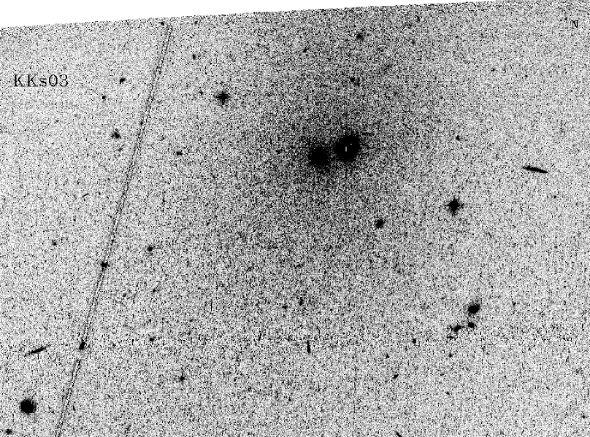One of the problems with astronomy is best portrayed by an old joke: At night, a cop notices a kid under a street light, looking intently all around him. The cop walks over and asks, “What are you doing, son?” The kid responds, “I lost a dollar, and I’m looking for it.”
The cop looks around for a moment, then asks, “Well, where did you lose it?”
The kid points over to a dark spot across the street. “Over there.”
“Well then, why are you looking over here?” the cop responds, reasonably.
The kid shrugs his shoulders. “The light’s better here.”
Such is astronomy. It’s easy to find the bright stuff, but the fainter objects are tougher, and we sometimes forget about them.
But they’re important. And that’s why the discovery of KKs 3 is so interesting: It’s a dinky spheroidal dwarf galaxy, thought to be the basic building blocks of much beefier galaxies like our Milky Way. Fewer than two dozen are known, so every new one is a gift.
KKS 3 is located about seven million light years away, which is pretty close by—just across the street, so to speak. But it’s fairly isolated, too. The Milky Way is part of a small clump of galaxies called the Local Group, and along with the Andromeda spiral galaxy we’re the two biggest. Most are small dwarf galaxies, and we’re all clustered into a volume of space roughly seven million light years across.
That puts KKs 3 well outside our group. There are other nearby groups, but KKs 3 isn’t a part of them either. It appears to be truly isolated.
It’s small, too: It has a total mass of about 20 million times that of the Sun. The Milky Way’s mass is 10,000 times larger! That makes KKs 3 incredibly faint. It’s amazing it was found at all. It was discovered in 2000, but not conclusively shown to be isolated until this new study using the Hubble Space Telescope. The image at the top of this post shows the galaxy. You can see it as a faint, spread-out smear in this negative image. By coincidence it happens to lie in the sky right next to a globular cluster, a smaller ball of stars presumably orbiting the Milky Way. Not only that but a pair of red stars in our galaxy happens to lie right in the middle of KKs 3.
This shows how hard it is to find these suckers. They don’t exactly stand out. Even faint nearby stars can confuse the surveys.
KKs 3 is also old. The majority of stars in it formed about 12-14 billion years ago in one big episode of star birth; that wasn’t long after the Universe itself formed. It had a couple of other, smaller bursts of star formation long ago, but ran out of gas (literally) after the last one, and no new stars have been created.
But this is all great news for astronomers: KKs 3 is a relic, so isolated and old it probably hasn’t changed much in a long, long time. Studying it is like having a time machine to study the ancient Universe. And we think that, billions of years ago, collisions between small galaxies like KKs 3 are what built up much larger galaxies. We know that the Milky Way is currently eating a few other small galaxies, so we can study those events and compare them to what we see in KKs 3 to learn more about how this process may have occurred so far in the past.
I know that photo of KKs 3 doesn’t look like much; splashier galaxies are so much easier and fun to look at. But this doesn’t make it any less important. You can search where the light is bright all you want, but if what you’re looking for isn’t there, well, what are you going to find?
